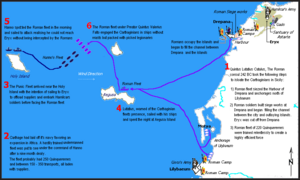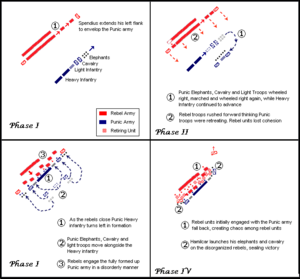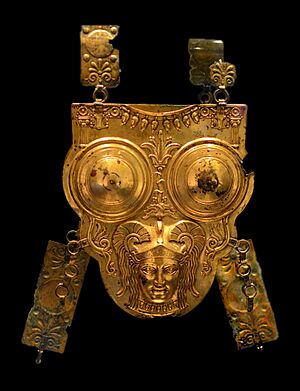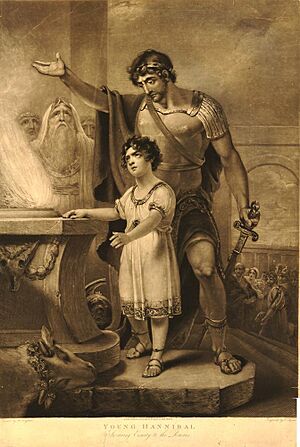Hamilcar Barca facts for kids
Quick facts for kids
Hamilcar Barca
|
|
|---|---|
| Born | c. 275 BC |
| Died | 228 BC (aged around 46–47) |
| Title | Carthaginian General |
| Term | 19 years; 247–228 BC |
| Successor | Hasdrubal the Fair |
| Spouse(s) | Unknown |
| Children | Hannibal Hasdrubal< Mago three daughters (names unknown) |
Hamilcar Barca (born around 275 BC, died 228 BC) was a famous Carthaginian general and leader. He belonged to the powerful Barcid family and was the father of the even more famous general, Hannibal. He was also the father-in-law of Hasdrubal the Fair.
Hamilcar led Carthage's ground forces in Sicily from 247 BC to 241 BC, during the last part of the First Punic War. He was very skilled at guerrilla warfare, fighting against the Romans. After Carthage lost the war in 241 BC, Hamilcar returned home. But when the Mercenary War broke out in 239 BC, he was called back to lead the army and helped Carthage win. In 237 BC, Hamilcar led a Carthaginian expedition to Spain, where he expanded Carthage's territory for eight years before he died in battle in 228 BC. Many historians believe he created the plan that his son Hannibal later used in the Second Punic War to almost defeat the Roman Republic.
What's in a Name?
The name Hamilcar comes from a Phoenician-Carthaginian name meaning "Melqart's brother." Melqart was an important god in Carthage.
His last name, Barca, means "thunderbolt" or "shining." It's similar to the Hebrew name Barak. This nickname probably showed how fast and powerful Hamilcar was in battle.
Hamilcar's Early Life
We don't know much about Hamilcar's family before the Punic Wars. Some historians say his family was powerful, but not among the very top families in Carthage. Hamilcar was quite young, about 28 years old, when he took command in Sicily in 247 BC. At this time, he already had three daughters, and his famous son, Hannibal, was born that same year.
Sicily's Situation During the War
The First Punic War started in 264 BC. By 249 BC, the Romans had taken most of Sicily. Carthage only held two cities: Lilybaeum and Drepanum. Carthage had a strong navy, but its leaders preferred to expand their land in Africa rather than fight more in Sicily.
Carthage was also struggling financially because of the long war. They were fighting in Africa too, so Hamilcar was given a small army and fewer ships. By 242 BC, Carthage had almost no ships left in Sicily.
Hamilcar's Campaigns in Sicily
Carthage's leaders likely thought Rome was defeated and didn't send many soldiers to Sicily. With a small army and little money, Hamilcar's goal was probably to keep the fight going, as he didn't have enough resources to win or make peace. Hamilcar was a very skilled commander, able to lead an army of soldiers from many different countries. He used clever tactics, similar to those used by Alexander the Great and Pyrrhus of Epirus.
Fighting Near Panormus (247 BC – 244 BC)
When Hamilcar took command in 247 BC, he first dealt with rebellious soldiers who hadn't been paid. He then began his operations. He raided areas in Italy, showing his boldness.
After that, Hamilcar captured a strong position on Mount Ercte (now Monte Pellegrino, near Palermo). From there, he launched raids all over Sicily and even into central Italy. He also trained his army to be very disciplined and adaptable. Even though Hamilcar didn't win any huge battles or take back cities, he kept up a constant fight against the Romans, wearing down their resources.
Moving to Eryx (244 BC – 241 BC)
In 244 BC, Hamilcar secretly moved his army by sea to Mount Eryx (Monte San Giuliano). This allowed him to support the Carthaginian soldiers defending the nearby city of Drepanum. Hamilcar captured the town of Eryx, which the Romans had taken earlier, and placed his army between the Roman forces. He continued his attacks from this new position for two more years.
During one raid, some of Hamilcar's soldiers disobeyed orders and were attacked by the Romans. Hamilcar asked for a truce to bury his dead, but the Roman commander refused. Later, Hamilcar defeated the Romans and, when their commander asked for a truce, Hamilcar granted it, saying his fight was only with the living.
Hamilcar's constant fighting, even without big victories, made the Romans decide to build a new fleet in 243 BC to try and win the war at sea.
The Peace Treaty of Lutatius
After the Romans won a major naval battle, Carthage had to make peace. The initial terms were:
- Carthage would leave all of Sicily.
- Carthage would not attack Syracuse or its allies.
- Carthage would pay Rome 2,200 silver talents (a large sum of money) over 20 years.
- Carthage's army would give up their weapons and any Roman deserters.
Hamilcar Barca refused to surrender Roman deserters or disarm his Carthaginian soldiers. The Roman commander, Lutatius, did not force the issue. This meant Hamilcar's soldiers were allowed to leave Sicily with their weapons and honor, which was rare for a defeated army.
Rome later changed the terms, making them harsher:
- Carthage had to leave all islands between Italy and Sicily, including the Aegates Islands.
- Carthage had to pay 3,200 talents in total, with 1,000 talents paid immediately and the rest over 10 years.
- Carthage would pay for its own prisoners, but Roman prisoners would be freed for free.
- Carthaginian warships could not sail near Italian shores.
- Neither side could attack the other's allies or try to change their loyalty.
After the treaty, Hamilcar returned to Carthage and retired from military life. He left the government to pay his soldiers, which caused big problems later on.
The Truceless War
Hamilcar's army, which had never been defeated, now caused a problem for Carthage. About 20,000 soldiers needed to be paid. The Carthaginian government delayed paying them, hoping to convince them to accept less money. But Hamilcar's former soldiers, who had been held together by his leadership and promises of good pay, rebelled. This started a conflict known as the Mercenary War.
The rebels, led by Spendius and Matho, were joined by 70,000 African people who were tired of Carthaginian rule. They attacked the cities of Utica and Hippo and cut off Carthage from the mainland.
Hamilcar is Called Back
Hanno the Great was first given command of the Carthaginian army. He had some early success but then failed to defeat the rebels. So, the Carthaginian government called Hamilcar Barca back to lead the army. He was given about 10,000 soldiers and 70 elephants.
Battle of Macar River
The rebels controlled the hills west of Carthage and the only bridge over the Bagradas river. Hamilcar noticed that a sandbar at the river's mouth became fordable when the wind blew in a certain direction. Under the cover of night, Hamilcar's army crossed the river.
Hamilcar planned to attack the small rebel group guarding the bridge. But Spendius, leading the rebel army besieging Utica, came to face Hamilcar. Hamilcar's army was caught between two rebel forces. Hamilcar pretended to retreat, making the rebels think they were winning. As the rebels rushed forward in a disorganized way, Hamilcar's well-trained soldiers suddenly turned around and attacked.
Hamilcar's clever tactics led to a big defeat for the rebels. He killed 8,000 mercenaries and captured 2,000. Hamilcar then took control of the bridge and the surrounding area.
Hamilcar Trapped and Saved
Hamilcar's victory opened the way to Utica. Spendius gathered his forces and followed Hamilcar, trying to avoid direct battle. Eventually, Hamilcar's army was trapped in a valley.
Luckily, a Numidian chief named Naravas, who would later marry Hamilcar's third daughter, joined Hamilcar with 2,000 horsemen. This help allowed Hamilcar to escape the valley and defeat Spendius's army in a tough battle. Hamilcar offered the captured rebels a choice: join his army or leave Africa and never fight Carthage again.
Horrible Actions Begin
The rebel leaders feared their soldiers would desert because of Hamilcar's kind treatment of prisoners. To stop this, they committed a terrible act: they killed Gisco and other Carthaginian prisoners. They announced they would do the same to all future Carthaginian prisoners. In response, Hamilcar also killed his prisoners and said he would do the same to rebel prisoners. This ended any chance of peace and made the war even more brutal.
Carthage's Comeback
Carthage faced more problems, including a storm that sank their supply ships and a rebellion in Sardinia. Also, Hamilcar and Hanno the Great struggled to work together.
However, things changed when Syracuse and then Rome came to Carthage's aid. Syracuse sent more supplies, and Rome helped Carthage by forbidding trade with the rebels and freeing Carthaginian prisoners. The Carthaginian people then chose Hamilcar Barca as the sole commander of their army.
Ending the Rebellion
Spendius and Matho tried to blockade Carthage by land. Hamilcar began to attack the rebel supply lines, putting them in a difficult position. Hamilcar eventually managed to trap about 40,000 rebels in a valley.
The Gorge of the Saw
The rebels in the valley ran out of food. Their leaders, including Spendius, went to Hamilcar's camp to ask for terms. Hamilcar offered to let all rebels leave freely, except for 10 people he would detain. When the leaders agreed, Hamilcar detained them. Without their leaders, and fearing betrayal, the rebels attacked Hamilcar's forces. Hamilcar's army slaughtered the rebel army, with elephants trampling many to death.
Final Victory
Hamilcar then moved to fight Matho's army at Tunis. He divided his army, trapping Matho's forces. Hamilcar crucified Spendius and other rebel leaders outside Tunis to scare Matho. However, the rebels surprised and defeated part of Hamilcar's army, capturing Hannibal (Hamilcar's deputy, not his son) and 30 Carthaginian senators. Matho then crucified his prisoners on the same crosses Hamilcar had used.
The Carthaginian senate then made Hanno the Great share command with Hamilcar again. The two generals pursued Matho's army and eventually destroyed it in a decisive battle. After this, the Libyan towns surrendered to Carthage. By the winter of 238 BC, the Mercenary War was over.
Sardinia's Loss
During the Mercenary War, Carthaginian soldiers in Sardinia rebelled and took over the island. They asked Rome to take control, but Rome refused at first. However, the rebels treated the native Sardinians badly, who then drove them out. The expelled mercenaries went to Italy and again asked Rome for help.
Rome, which had been helpful to Carthage during the Mercenary War, suddenly changed its mind. It seized Sardinia and Corsica and forced Carthage to pay an additional 1,200 talents. This unfair act deeply angered Carthage and is seen as a major reason for the Second Punic War.
Hamilcar's Rise in Carthage
After the Mercenary War and the loss of Sardinia, Hamilcar was blamed by some Carthaginian leaders for causing the Mercenary War. However, Hamilcar was very popular with the people. He also allied with Hasdrubal the Fair, who would become his son-in-law. This allowed Hamilcar to avoid being put on trial and gain more power in Carthage.
Hamilcar's main goals were to make sure Carthage paid its war debt to Rome regularly so Rome had no excuse to interfere. He also wanted to prepare Carthage for any future conflicts with Rome.
Operations in North Africa
Hamilcar got permission from the Carthaginian Senate to recruit and train a new army. He used this army to secure Carthage's lands in Africa. Then, Hamilcar marched his army west towards the Pillars of Hercules (Straits of Gibraltar). Hasdrubal the Fair commanded the fleet that carried supplies along the coast.
Without the Carthaginian government's full permission, Hamilcar then took his army across to Gades (in modern Spain) in 237 BC. He planned to build a new empire in Hispania (Spain) to make up for the loss of Sicily and Sardinia. Spain would also be a base for future wars against Rome, free from political interference from Carthage.
Building an Empire in Spain
Hamilcar probably landed in Gades in the summer of 237 BC. Hasdrubal the Fair and Hamilcar's young son, Hannibal, who was nine years old, went with him. Legend says that before leaving Carthage, Hannibal swore an oath never to be a "Friend of Rome."
Spain's Political Situation
When Hamilcar arrived, Carthage had lost most of its direct control in Spain. Phoenician colonies were along the coast, but they mostly traded with the local tribes. The Iberian and Celtiberian tribes were not united and were often at war.
Securing Silver Mines
Hamilcar's first goal was to control the rich gold and silver mines in the Sierra Morena mountains. He made deals with some tribes but faced resistance from others. Hamilcar defeated these tribes, killing their leaders and taking some of their soldiers into his own army.
After securing the mines, Gades began to mint silver coins in 237 BC. Carthage likely took over the mining operations and used new methods to increase production. This gave Hamilcar the money to pay his army and send silver to Carthage to help pay off the war debt to Rome. Hamilcar was so secure in Spain that he could even send Hasdrubal the Fair with an army back to Africa to put down a rebellion there.
Expanding Eastward (235 BC – 231 BC)
After controlling the mines, Hamilcar moved east from Gades. He faced strong resistance from Iberian tribes. For four years, Hamilcar fought constant campaigns, slowly taking control of the area between Gades and Cape Nao. During this time, he built a strong, professional army of soldiers from different regions. This army would later be led by Hasdrubal the Fair and then by Hannibal.
By 231 BC, Hamilcar had secured his gains in Spain and founded the city of Akra Leuke (possibly Alicante) to protect Carthaginian lands.
Rome Takes Notice
While Hamilcar was fighting in Spain, Rome was busy with its own wars in Sardinia, Corsica, and Liguria. Rome suspected Carthage was helping the native tribes there. Roman ambassadors visited Hamilcar in Spain in 231 BC to ask about his activities. Hamilcar simply replied that he was fighting to get enough money to pay off Carthage's war debt. The Romans left and didn't bother the Carthaginians in Spain again until 226 BC.
Hamilcar's Final Campaigns (231 BC – 228 BC)
After founding Akra Leuke, Hamilcar began moving northwest. In the winter of 228 BC, Hamilcar divided his forces. He sent Hasdrubal the Fair on a separate campaign, while Hamilcar besieged an Iberian town. Hamilcar's sons, Hannibal and Hasdrubal, were with him.
Hamilcar's Death
The chieftain of the Oretani tribe, Orissus, came to help the besieged town. There are different stories about how Hamilcar died:
- Some say Orissus offered to help Hamilcar, then attacked the Carthaginian army. Hamilcar drowned while retreating across a river.
- Others say the Oretani sent burning carts towards the Carthaginians, and Hamilcar died in the chaos.
- Another story says Hamilcar pretended to surrender, then led the enemy in one direction while his sons, Hannibal and Hasdrubal, escaped in the other.
- Most historians agree he died in battle in an unknown part of Spain against an unnamed tribe.
In eight years, Hamilcar had gained a large territory in Spain through fighting and diplomacy. But his early death in 228 BC meant Carthage couldn't complete its conquest. Legend says he founded the city of Barcino, which later became Barcelona, named after his family.
Family

Hamilcar had at least three daughters and three sons.
- His first daughter married Bomilcar, a Carthaginian leader. Their son, Hanno, became an important commander in Hannibal's army.
- His second daughter married Hasdrubal the Fair.
- His third daughter married Naravas, the Numidian chief who helped Hamilcar during the Mercenary War.
Hamilcar's three sons were Hannibal, Hasdrubal, and Mago. All of them became distinguished military leaders.
Hamilcar's Legacy: A Grand Plan
Hamilcar was an outstanding Carthaginian leader, known for his military and diplomatic skills and his love for his country. Many believe he passed on his strong dislike of Rome to his son, Hannibal, and trained him to continue the fight. Some historians say that if Hamilcar hadn't been Hannibal's father, his achievements in Sicily might not be as well-known.
Hamilcar is considered one of the best commanders of the First Punic War. He crushed the Mercenary War rebellion through his leadership, clever strategies, and some luck, even though the war was very brutal on both sides.
An Enemy of Rome
Rome's unfair seizure of Sardinia after the Mercenary War destroyed any real chance of lasting peace between the two powers. According to the historian Polybius, the main reasons for the Second Punic War were:
- Hamilcar felt Carthage gave up Sicily too soon in the First Punic War, especially since he was undefeated.
- Rome's occupation of Sardinia and Corsica showed that Romans could not be trusted and would interfere regardless of treaties. This was the most important reason for the Second Punic War.
- Hamilcar and his family's success in Spain rebuilt Carthage's finances and created a strong army, giving Carthage the means to fight Rome again.
Based on this, and Hannibal's oath, some historians believe Hamilcar's actions after the Mercenary War were aimed at eventually fighting Rome. Some even suggest Hamilcar planned the strategy of invading Italy by crossing the Alps, which Hannibal later carried out. However, without Carthaginian records, these ideas remain theories.
Hamilcar in Books
- Salammbô, a novel by Gustave Flaubert
- Pride of Carthage, a novel by David Anthony Durham
- "Hamilcar Barca," a poem by Roger Casement
See also
 In Spanish: Amílcar Barca para niños
In Spanish: Amílcar Barca para niños
- Barcids, Hamilcar's family
- Battle of the Bagradas








